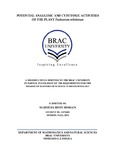| dc.contributor.advisor | Hossain, M. Mahboob | |
| dc.contributor.author | Hossain, Mahmuda Binte | |
| dc.date.accessioned | 2017-02-27T10:03:34Z | |
| dc.date.available | 2017-02-27T10:03:34Z | |
| dc.date.copyright | 2016 | |
| dc.date.issued | 2016-03 | |
| dc.identifier.other | ID 12276002 | |
| dc.identifier.uri | http://hdl.handle.net/10361/7794 | |
| dc.description | A Dissertation Submitted in Partial Fulfillment of the Requirements’ for the Degree of Master of Science in Biotechnology 2016. | en_US |
| dc.description | Cataloged from PDF version of thesis report. | |
| dc.description | Includes bibliographical references (page 57-62). | |
| dc.description.abstract | Typhonium trilobatum, a plant of Araceae family, containing many important chemical
compounds was studied for its analgesic activity in three experimental models of
nociception. The analgesic activity of crude chloroform extract of root, shoot and leaf,
and the petrolium ether fraction of leaf, were evaluated by using acetic acid induced
writhing method; formalin induced licking method and hot plate test on Swiss albino
mice at doses of 200mg/kg and 400mg/kg body weight. In addition, cytotoxic activity of
leaf, tuber and pet ether fraction was examined with brine shrimp lethality bioassay. The
plant extract demonstrated a significant inhibition of writhing, licking and heat tolerance
compared with the control group. The leaf extract showed 52.00% and 66.55%; tuber
extract showed 38.57% and 53.78%, and the pet ether fraction of leaf showed 31.55%
and 50.67% of inhibition of writhing during acetic acid induced writhing test at 200
mg/kg/dose and a bit of higher percentage of inhibition at 400 mg/kg/dose respectively.
In addition, the percentages of inhibition were 35.67% and 41.67% for leaf extract for
hot plate test at these dose levels. In case of formalin induced licking test, both the two
group of mice showed more than 90% of inhibition of licking. Overall, the percentages
of inhibition were 67.55%, 53.78% and 50.67% for the leaf, tuber and pet ether fraction
of leaf. Morphine 5 mg/kg/dose was used as positive control and exhibited 76.0%
inhibition compare to control. On the other hand, all the type of three different extracts
showed the presence of cytotoxity over the brine shrimp, where vincristine sulfate was
used as positive control. These results define that the extract possesses significant
analgesic and cytotoxic activities that support to the ethnopharmacological uses of this
plant. Hence, the obtained results in this project work provide a support for the use of
this plant for medicinal purposes and encourage further investigation for more fruitful
results. | en_US |
| dc.description.statementofresponsibility | Mahmuda Binte Hossain | |
| dc.format.extent | 63 pages | |
| dc.language.iso | en | en_US |
| dc.publisher | BRAC University | en_US |
| dc.rights | BRAC University thesis are protected by copyright. They may be viewed from this source for any purpose, but reproduction or distribution in any format is prohibited without written permission. | |
| dc.subject | Typhonium trilobatum | en_US |
| dc.title | Potential analgesic and cytotoxic activities of the plant Typhonium trilobatum | en_US |
| dc.type | Thesis | en_US |
| dc.contributor.department | Department of Mathematics and Natural Sciences, BRAC University | |
| dc.description.degree | M. Biotechnology | |

